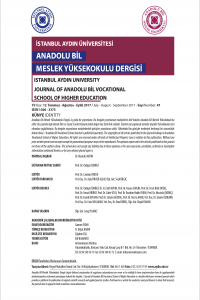Sosyal Bilimlerde “Sınır Kapsamı” Rolü
Bu makalede sosyal bilimlerde sıkça konu edilen “sınır kapsamı” rolü ele alınmıştır. Yabancı kaynaklarda sınır kapsamı rolü hakkında çalışmalar olduğu halde ülkemizde konunun nadir bir şekilde dikkate alındığı ve sadece bir ders konusu olarak kısaca anlatıldığı görülmüştür. Bu makale ile sınır kapsamı rolü hakkında daha detaylı bilgi verilmesi amaçlanmaktadır
Anahtar Kelimeler:
Sınır kapsamı, rol, sosyal bilimler, grup, takım
“Boundary Spanning” Role in Social Sciences
In this article “boundary spanning” role, which is frequently subjected in social sciences, was taken into consideration. It was seen that although there are studies about boundary spanning role in foreign sources, the subject is considered rarely and is only told briefly as a lesson subject in our country. With this article, it is aimed to give more detailed information about boundary spanning role
Keywords:
Boundary spanning, role, social sciences, group, team,
___
- Adams, J. S., 1980: “Interorganizational Processes and Organization Boundary Activities”, s. 355, Research in Organizational Behavior, Ed. B. W. Staw ve L. L. Cummings,
- Connecticut, JAI Press. Aldrich, H. E., 1979: Organizations and Environments, New Jersey, Prentice-Hall.
- Aldrich, H. E. ve D. Herker, 1977: “Boundary Spanning Roles and Organization Structure”,
- Academy of Management Review, 2(2), s. 217–230. Almeida, P. ve B. Kogut, 1997: “The exploration of technological diversity and the geographic localization of innovation”, Small Business Economics, 9 (1), s. 21–31.
- Caplan, R. D., S. Cobb ve J. R. P., Jr. French, 1975: “Job demands and worker health”, US
- Department of Health, Education, & Welfare, National Institute for Occupational Safety and Health, Washington, DC. Churchill, G. A., N. M. Ford ve O. C. Walker, 1974: “Measuring the job satisfaction of industrial salespeople”, Journal of Marketing Research, 11, 254–260.
- Cross, R. ve L. Prusak, 2002: “The People Who Make Organizations Go-Or Stop”, Harvard
- Business Review, R0206G, s. 5-12.
- Dailey, R. C., 1979: “Group, Task and Personality Correlates of Boundary-Spanning Activities”, Human Relations, 32(4), 273-285.
- Geletkanycz, M. A., ve D. C. Hambrick, 1997: “The external ties of top executives:
- Implications for strategic choice and performance”, Administrative Science Quarterly, 42, s. –681. Hambrick, D. C., 1981: “Environment, Strategy, and Power Within Top Management
- Teams”, Administrative Science Quarterly, 26(2), s. 253–273. Jackson, S. E. ve R. S. Schuler, 1985: “A meta-analysis and conceptual critique of research on role ambiguity and role conflict in work settings”, Organizational Behavior and Human Decision Processes, 36, s. 16–78.
- Jemison, D. B., 1984: “The Importance of Boundary Spanning Roles in Strategic Decision
- Making.”, Journal of Management Studies, 21(2), s. 131–152. La Rocco, J. M., J. S. House ve J. R. P. Jr. French, 1980: “Social support, occupational stress and health”, Journal of Health and Social Behavior, 21, s. 202–216.
- Marchington, M. ve S. Vincent, 2004: “Analysing the Influence of Institutional, Organizational and Interpersonal Forces in Shaping Inter-Organizational Relations”, Journal of Management Studies, 41(6), 1029–1056.
- Miles, R. ve W. Perreault, 1976: “Organizational role conflict: Its antecedents and consequences”, Organizational Behavior and Human Performance, 17(1), s. 19–44.
- Pettigrew, A., 1972: “Information Control as a Power Resource.”, Sociology, 6(2), s. 187-204.
- Podolny, J.M. ve T.E. Stuart, 1995: “A Role-Based Ecology of Technological Change”,
- American Journal of Sociology, 100 (5), s. 1224–1260.
- Podsakoff P. M., S. B. MacKenzie, J. B. Paine ve D. G. Bachrach, 2000: “Organizational
- Citizenship Behaviors: A Critical Review of the Theoretical and Empirical Literature and Suggestions for Future Research”, Journal of Management, 26(3), s. 513-563. Reimann, B.C., 1975: “Organizational Effectiveness and Management’s Public Values: A
- Canonical Analysis”, Academy of Management Journal, 18, s. 224-241. Rizzo, J. R., R. J. House ve S. I. Lirtzman, 1970: “Role conflict and ambiguity in complex organizations”, Administrative Science Quarterly, 15, s. 150–163.
- Rosenkopf, L. ve A. Nerkar, 2001: “Beyond local search: Boundary, spanning, exploration and impact in the optical disc industry”, Strategic Management Journal, 22 (4), s. 287–306.
- Russ, G.S., M.C. Galang ve G.R. Ferris, 1998: “Power and Influence Of The Human Resources
- Function Through Boundary Spanning and Information Management”, Human Resource Management Review, 8(2), s. 125-148. Schwab, R., J. Ungson ve W. Brown, 1985: “Redefining the boundary-spanning environment relationship”, Journal of Management, 11, s. 75-86.
- Shermerhorn, J.R., 1975: “Determinants of Interorganizational Cooperation”, Academy of
- Management Journal, 18, s. 846-856. Singh, J., 1993: “Boundary role ambiguity: Facets, determinants, and impacts”, Journal of Marketing, 57, s. 11–31.
- Singh, J. ve G. K. Rhoads, 1991: “Boundary role ambiguity in marketing-oriented positions: A multidimensional, multifaceted operationalization”, Journal of Marketing Research, 28, s. 328–
- Spekman, R. E., 1979: “Influence and Information: An Exploratory Investigation of the Boundary Role Person’s Basis of Power”, Academy of Management Journal, 22(1), s. 104–117.
- Starbuck, W. H., 1976: “Organizations and Their Environments.”, s. 1069-1123, Handbook of lndustrial and Organizational Psychology, Ed. M. D. Dunnette, Chicago, Rand McNally.
- Sujan, H., B. A.Weitz ve N. Kumar, 1994: “Learning Orientation,Working Smart, and Effective Selling”, Journal of Marketing, 58, s. 39-52.
- Thompson, J. D., 1967: Organizations in Action, New York, McGraw Hill.
- Tubre, T. C. ve J. M. Collins, 2000: “Jackson and Schuler (1985) revisited: A meta-analysis of the relationships between role ambiguity, role conflict, and job performance”, Journal of Management, 26(1), s. 155–169.
- Tushman, M.L. ve T.J. Scanlon, 1981(a): “Characteristics and external orientations of boundary-spanning individuals”, Academy of Management Journal, 24, s. 83–98.
- Tushman, M.L. ve T.J. Scanlon, 1981(b): “Boundary-spanning individuals: Their role in information transfer and their antecedents”, Academy of Management Journal, 24, s. 289–305.
- Weatherly, K. A. ve D. A Tansik, 1993: “Tactics used by customer-contact workers: Effects of role stress, boundary spanning, and control”, International Journal of Service Industry Management, 4(3), s. 4–17.
- Weber, M., 1947: The Theory of Social and Economic Organization, Ed. A. M. Henderson ve Talcott Parsons, New York, New York Oxford University Press.
- ISSN: 1306-3375
- Başlangıç: 2006
- Yayıncı: İstanbul Aydın Üniversitesi
